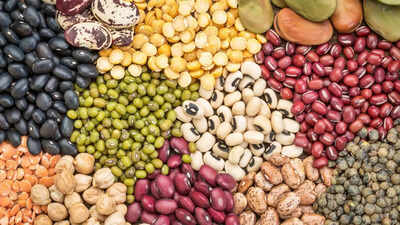ARTICLE AD BOX

For millions of Indian families, a bowl of dal is more than just food. It’s comfort, culture, and daily nourishment. Packed with fibre, gentle on digestion, and easy to cook, dal has long been considered a dependable source of “vegetarian protein.
” But how true is this belief when it comes to meeting the body’s actual protein needs?In a recent Instagram post, nutrition expert Dr Shubham Vatsya addressed this common idea. “Dal does contain protein, but not enough to meet your body’s full requirement,” he explained. His remark sparked a debate across fitness and health circles, prompting many to rethink how they view plant-based proteins.So, how much protein does dal really have? And can it alone provide what your body needs? Here’s what experts say.
How much protein is in dal: Understanding the real protein content in Indian lentils
Many people assume dal is rich in protein, but the real numbers show otherwise. According to Dr Vatsya, “A hundred grams of raw dal gives around 24 grams of protein.” But once cooked, that figure drops.Cooking causes lentils to absorb water and swell, which reduces their protein density. “One hundred grams of cooked dal makes up about five to six bowls,” Dr Vatsya noted. “That means a single bowl of dal contains roughly four to five grams of protein.”
In practical terms, even two bowls of dal, a fairly generous serving, provide only about 8–10 grams of protein. For most adults, that’s much lower than what’s needed per meal for muscle recovery, energy, or overall health. The average adult requires around 60–80 grams of protein daily. To reach that only through dal, you’d have to eat a very large quantity, which isn’t realistic or balanced.Dal still offers plenty of nutritional value. It’s high in fibre, packed with minerals, and easy on digestion.
But relying on it as your main source of protein can leave your diet short of what your body actually needs.
Why dal is an incomplete source of protein and what that means for your health
Protein quality isn’t just about how much you eat; it’s also about the type of amino acids it provides. For a food to count as a “complete protein,” it must contain all nine essential amino acids that the body can’t make on its own. These amino acids are crucial for muscle growth, tissue repair, and even hormone regulation.Dal, however, doesn’t have all of them. As Dr Vatsya explains, “Dal is an incomplete protein source because it lacks certain essential amino acids. This limits how effectively the body can use the protein it provides.”So, even if you eat enough dal, your body may not absorb or use the protein properly unless you combine it with other foods that fill those gaps. This is especially important for people who follow vegetarian or vegan diets.
Without thoughtful pairings, much of the protein in dal may not benefit you as much as you expect.
Smart food combinations to make dal high in protein
The good news is, you don’t have to give up dal; you just need to pair it wisely. When combined with foods rich in the amino acids it lacks, dal becomes a more balanced, high-quality protein source.Dr Vatsya suggests adding paneer, eggs, curd, or whey protein to your diet. “These foods complement dal well and help create a plate that supports muscle building, gut health, and overall strength,” he says.Here are some simple and effective combinations:
- Dal with paneer (cottage cheese):
Paneer adds complete dairy protein. You can mix small paneer cubes into dal or have them on the side. Together, they form a meal that covers more amino acids and boosts overall protein content.
Adding eggs, whether boiled, scrambled, or lightly fried, makes your meal complete in terms of protein. This pairing is especially useful for people who work out or aim to build lean muscle.
- Dal with curd or Greek yoghurt:
Curd not only offers complete protein but also contains probiotics that support digestion. Eating curd alongside dal can improve protein absorption and help maintain gut balance.
If your protein needs are higher, consider adding a scoop of whey protein to your daily intake. Whey digests quickly and complements lentil-based meals effectively.By combining dal with any of these, you turn a simple lentil curry into a well-rounded, protein-rich meal that fuels your body better.
Instead of being mainly carb-heavy, your thali becomes balanced and nourishing.
Why balance matters: Making the most of dal in your diet
Dal will always remain a staple in Indian kitchens. It’s affordable, filling, and full of essential nutrients. But it’s time to stop viewing it as the single best source of protein. As Dr Vatsya says, “Dal is good, but not enough. Combine it smartly if you want your meals to truly support your body.”Balancing dal with protein-rich foods like paneer, eggs, curd, or whey doesn’t just meet your daily needs, it also improves energy, supports muscle health, and keeps you full for longer.So the next time you sit down to a plate of rice and dal, think of it as a starting point. A few thoughtful additions can turn this everyday meal into a powerful, complete source of nourishment.Also Read | Coconut water or ORS: What is the best way to rehydrate after dehydration

 1 day ago
6
1 day ago
6









 English (US) ·
English (US) ·